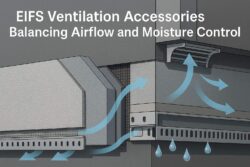Unlocking the Longevity of EIFS Stucco: The Critical Role of Expansion Joints
Stucco cracks are the bane of every homeowner’s existence. Even small fissures in your home’s exterior finish can lead to costly repairs down the road. But what if I told you that many stucco cracks are preventable with proper design and installation?
In this comprehensive guide, we’ll cover everything you need to know about achieving long-lasting, crack-resistant exteriors with EIFS stucco systems. You’ll learn why and where to use expansion joints, optimal EIFS materials and methods, keys to proper flashing and sealing, and more tips to get durable exteriors that stand the test of time.
A Summary of Why Expansion Joints Matter for EIFS Stucco
Before we dive in, let’s quickly summarize the key reasons expansion joints are so crucial for EIFS stucco systems:
- They accommodate movement and relieve stress that causes cracks. All materials expand and contract. Expansion joints give stucco room to move.
- They compartmentalize the wall system. Expansion joints divide the stucco facade into “panels”, limiting the spread of cracks.
- They provide openings for proper drainage and moisture control. Joints allow water to escape from the stucco system.
- Proper design and installation of joints prevent many common stucco failures. They are a weak link when done wrong.
By understanding expansion and contraction in EIFS stucco, builders can design reliable, long-term exterior finishes. Now let’s look at the details.
Outline of This Comprehensive EIFS Stucco Guide
Below is an outline summarizing the topics we’ll cover in this guide:
- What is Stucco and EIFS?
- Why Does Stucco Crack Without Expansion Joints?
- Stucco shrinkage
- Forces that cause stucco cracking
- Where are Expansion Joints Needed in EIFS Construction?
- Vertical joints
- Horizontal joints
- Other locations
- Joint Spacing – How Far Apart Should They Be?
- What Are Expansion Joints Made Of?
- How to Install Expansion Joints Correctly
- Other EIFS Design Tips for Crack Prevention
- Materials
- Lath
- Flashing
- Sealants
- Coatings
- Signs of Expansion Joint Failure
- Costs of Repairing Cracked Stucco
- Summary – Keys to Durable, Long-Lasting Stucco Finishes
Now let’s explore each of these topics in detail…
What Exactly is Stucco and EIFS?
Before discussing expansion joints, we need to cover some stucco basics. Stucco refers to cement-based plaster coatings applied to exterior walls over some type of solid backing. Traditional stucco consists of a scratch coat, brown coat, and finish coat over masonry.
EIFS, or Exterior Insulation and Finish Systems, are multi-layer stucco assemblies that incorporate rigid foam insulation boards. This provides an added R-value compared to traditional stucco.
The EIFS layers include adhesive, insulation boards, reinforced base coat, and textured acrylic finish coat. EIFS is sometimes called “synthetic stucco” and provides a durable, attractive exterior finish.
Why Does Stucco Crack Without the Flexibility of Expansion Joints?
Stucco’s cement-based nature makes it prone to cracking without proper accommodations for expansion and contraction. Here are the key forces leading to stucco cracks:
Stucco Shrinkage:
- As stucco cures, drying shrinkage causes cracking where movement is restricted. All cement plaster shrinks as excess water leaves.
Thermal Movements:
- Daily and seasonal temperature swings cause stucco to continually expand and contract. Just a 50°F change can expand stucco enough to crack it.
Structural Forces:
- Natural forces like earthquakes, wind, or settling can stress the stucco from underlying building movements.
Impact Damage:
- Objects hitting exterior walls create immediate cracks or strains that lead to delayed cracking.
Without joints designed to relieve these stresses, stucco finishes will crack, leading to threats like water intrusion, damage from freeze-thaw cycles, compromised fire resistance, and costly repairs.
Where are Expansion Joints Required in EIFS Construction?
Expansion joints are necessary at regular intervals on walls and at key locations prone to movement. Let’s look at the placement of vertical and horizontal joints, as well as other important expansion joint applications.
Vertical Expansion Joints
Vertical joints in the EIFS cladding are needed at the following locations:
- Where the stucco meets windows, doors, columns, and other openings/projections. The perimeter must allow for free movement.
- At external wall corners. This isolates cracking from each wall plane.
- Where separate building materials meet the stucco, such as brick or wood siding.
- At control joints built into concrete/masonry substrate walls. These relieve stress from the wall framing.
- On long expanses of stucco walls. Intermediate joints compartmentalize the facade into smaller panels.
Horizontal Expansion Joints
Horizontal joints in EIFS stucco should be installed:
- At floor lines. This allows movement between floors of the structure.
- Where roofs and stucco walls intersect. Stucco must accommodate roof deflection.
- Above projecting features like balconies or bay windows. This prevents cracks from spreading.
- Near any areas prone to water collection, providing drainage paths.
Other Critical Expansion Joint Locations
In addition to the primary vertical and horizontal joints, expansion joints are also required:
- Where building wings intersect at different angles/planes.
- Near areas of potential vibration from machinery.
- At seismic or expansion joints built into the structure.
- Where conduit, piping, or other penetrations pass through the stucco.
- Anywhere else movement or cracking is anticipated.
Thoughtful design of EIFS expansion joints relieves stresses and controls cracks. Now let’s look at proper joint spacing.
What’s the Optimal Spacing Between EIFS Expansion Joints?
While specific EIFS assembly designs vary, these are typical maximum spacing guidelines between expansion joints:
- Vertical Joint Spacing – 25 feet or less. Some specifications limit to under 16 feet.
- Horizontal Joint Spacing – 15 to 20 feet, based on floor height.
- Panel size – No larger than 144 square feet between all joints.
Other factors like climate, building size, and substrate also impact ideal EIFS joint spacing. The key is allowing the stucco adequate flexibility to expand and contract through all seasons and temperatures. Follow manufacturer specifications for each assembly.
What Materials Makeup Expansion Joints in EIFS Construction?
Expansion joints consist of two main components – the backer material and sealant:
- Backer rod – Closed-cell polyethylene foam rod that provides sealant depth and shape control.
- Sealant – Flexible silicone, polyurethane, or other elastomeric sealant that bonds yet moves.
Additional parts like reveal strips, drainage inserts, factory-fabricated joints, and metal flashing may be specified. Backer and sealant selection depend on expansion anticipated, stucco coatings, and weatherproofing needs.
Step-by-Step Guide to Proper EIFS Expansion Joint Installation
Like any construction detail, correct installation is key to expansion joint performance. Follow these proven steps:
- Install backer rod slightly wider than joint size, then compress 25%.
- Clean and prime joint surfaces per sealant manufacturer instructions.
- Apply sealant, filling the joint cavity fully without gaps or air pockets.
- Tool sealant with a consistent concave shape to maximize adhesion.
- Ensure 1/4″ minimum sealant depth for proper expansion capability.
- Allow full sealant cure time before exposing to weather.
Then maintain with proper sealant inspection, cleaning, and replacements on a regular schedule. Get expansion joint installation right the first time and stucco reliability improves greatly.
Advanced EIFS Design Strategies to Further Prevent Cracking
Along with properly integrating expansion joints, consider these added tips for robust EIFS stucco designs:
- Enhanced materials – Add polymers to improve stucco strength and flexibility while reducing shrinkage.
- Durable lath – Use self-furred expanded metal lath to optimize the mechanical bond to the base coat.
- Reduced coat stress – Apply multiple thin stucco coats, allowing FULL drying between coats.
- Careful sealants – Seal penetrations, openings, and jobs meticulously to prevent water damage.
- Compatible coatings – Pick acrylic stucco finishes compatible with substrate and base coats.
- Conscientious flashing – Direct water away from the stucco with proper flashing at all openings and transitions.
- Good detailing – Avoid thin sections, feather edges, skimpy sealants, and other weaknesses.
Get expansion joint design, stucco materials, and detailing right to maximize EIFS stucco longevity and beauty.
Watch Out – Signs of EIFS Expansion Joint Distress or Failure
While a quality EIFS application should last decades, check for these potential signs of expansion joint problems:
- Cracking or crazing originating from joint edges – sealant is too stiff.
- Spalling or stucco loss around joints – poor installation or materials.
- Backer visible through sealant – inadequate width or sealant shrinkage.
- Excess sealant oozing – improper backer compression.
- Joint sealants cracking, shrinking, or showing their age.
- Gaps at joint interfaces – sealant pulled free from poor adhesion.
- Rust stains around joints – flashing issues allowing water in.
- Efflorescence deposits at joints – water penetrating the assembly.
Address any joint deficiencies immediately to avoid cascading stucco failures.
Beware the High Costs of Repairing Cracked EIFS Stucco
Neglecting expansion joints leads to extensive aesthetic and functional damage. Here are typical costs to repair cracked stucco:
- Minor crack repairs – $200 to $500 per crack.
- Local crack patching – $500 to $1,000 per wall section.
- Extensive resealing and recoating – $10,000+ for a whole house stucco job.
- Complete tear-off and replacement – $25,000 to $60,000 for a typical home.
And that doesn’t include interior water damage repair costs. Investing in quality stucco with proper expansion joints saves huge costs down the road.
Summary – Keys to Achieving Durable, Crack-Resistant EIFS Stucco
Let’s wrap up with a summary of the top recommendations for lasting, crack-free stucco exteriors:
- Design sufficient expansion joints into the stucco facade and structure.
- Locate joints strategically based on likely movement and material transitions.
- Space vertical and horizontal joints every 20 to 25 feet maximum.
- Use quality sealants and backers compatible with EIFS assembly.
- Incorporate joints into drainage, flashing, and detail considerations.
- Install joints meticulously according to manufacturer and industry standards.
- Select optimal stucco materials and compatible finishes.
- Follow best practices for modern EIFS application and detailing.
- Inspect and maintain joints regularly. Catch problems early.
Take these vital steps and your EIFS stucco finish will remain attractive and durable for decades, protecting your home’s value and comfort. Don’t gamble with stucco cracking – make expansion joints a priority for your next exterior project. Call Indiana Wall Systems at (765) 341-6020 or contact us for a free EIFS estimate today!


